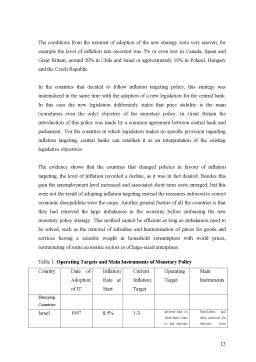Extras din proiect
MONETARY POLICY STRATEGIES
There are three types of monetary policy strategies:
Exchange rate targeting
Monetary aggregates targeting
Direct targeting of inflation
Monetary aggregates targeting is efficient only when the link between the aimed monetary aggregate’s evolution and the price level is a predictable one. This strategy supposes the enforcement of a restrictive monetary policy that would control the growth of monetary aggregates in order to remove excess liquidity; excess that leads eventually to the decrease of national purchasing power.
One of the problems arising when applying this strategy to target inflation is the maintenance of money supply below the growth level of production. Another problem is represented by the central bank’s ability of influencing the chosen aggregate as intermediary an establishing the money demand.
Exchange rate targeting implies that central bank to ensure nominal exchange rate stability using own instruments that refer to changes in interest rates and interventions for supporting exchange rate.
By using this strategy, the high level of stability of the national currency will intensify the international commercial flows and investments and the international cooperation will improve in case of major external shocks. Among the disadvantages there can be mentioned the necessity of preserving a low monthly inflation rate that would ensure the exchange rate level and external competition. There would be also impossible to adjust frequently the exchange rate because this would lead to decline in the creditworthiness of this strategy and of the central bank.
In the last years a new monetary policy emerged, inflation targeting. The necessity of adopting a new policy resides in the weakening of the relation between monetary aggregates and inflation and in the fact that exchange rate policy has high risks taking into account the liberalization of account capital.
INFLATION TARGETING – A NEW MONETARY POLICY FRAMEWORK
According to Murray Sherwin, direct inflation targeting represents the “monetary strategy which implies establishing, over a certain time period, a target for inflation rate, target that will be reached using measures taken to support price stability”. This concept was debated in the 80’s and the first country that adopted this strategy was New Zeeland in 1989.
Inflation targeting represents a superior step taken for controlling inflation, while being one of the most recent types of monetary policy. Inflation targeting can be defined as that framework of the monetary policy characterized by the public announcement of inflation target level, for one or more time horizons, and the explicit acknowledgement that a low inflation is the main objective of the long-run monetary policy.
It is widely accepted that the primary role of monetary policy is to maintain price stability. According to Alan Greenspan, Chairman of the Federal Reserve, price stability “obtains when economic agents no longer take account of the prospective change in the general price level in their economic decision making”. This is usually considered to correspond to an annual rate of inflation in the low single digits.
Particular Characteristics
The inflation targeting process has the following defining characteristics:
the primary objective of the monetary policy will be price stability and the other subordinate objectives- economic growth, increasing external competition, financing fiscal deficits or reducing unemployment rate- will be passed on a secondary place;
monetary policy will be transparent so that the objectives and decisions of fiscal policy will be shared to the public;
the responsibility of the central bank will increase because it will have to publish a report concerning inflation and inflation forecast;
dependence of due time delivery of a complete data set concerning relevant variable for real, monetary, fiscal and external macroeconomic blocks.
Among the price stability benefits there are:
better decision making regarding consumption and investments;
a low risk premium included in the interest rate leads to decrease of financing cost;
better resource allocation due to low risks and higher productivity;
decrease of market liquidity;
reduction of differentiated redistribution of incomes and social welfare in the economy;
the absence of a high rate of inflation decreases real assets investments, which are not considered to be the best investment decision.
The possibility to react more effectively in case of shocks represents the priority of direct inflation targeting. Direct inflation targeting joins the recognition of the inflationary phenomenon importance and the fact that idea that ensuring that price stability is the most efficient method for supporting long term economic growth.
Preview document
Conținut arhivă zip
- Inflation Targeting.doc
























